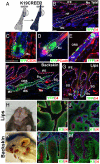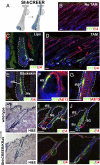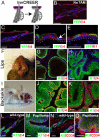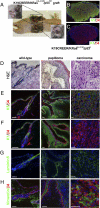Identifying the cellular origin of squamous skin tumors
- PMID: 21502497
- PMCID: PMC3088632
- DOI: 10.1073/pnas.1012720108
Identifying the cellular origin of squamous skin tumors
Abstract
Squamous cell carcinoma (SCC) is the second most frequent skin cancer. The cellular origin of SCC remains controversial. Here, we used mouse genetics to determine the epidermal cell lineages at the origin of SCC. Using mice conditionally expressing a constitutively active KRas mutant (G12D) and an inducible CRE recombinase in different epidermal lineages, we activated Ras signaling in different cellular compartments of the skin epidermis and determined from which epidermal compartments Ras activation induces squamous tumor formation. Expression of mutant KRas in hair follicle bulge stem cells (SCs) and their immediate progeny (hair germ and outer root sheath), but not in their transient amplifying matrix cells, led to benign squamous skin tumor (papilloma). Expression of KRas(G12D) in interfollicular epidermis also led to papilloma formation, demonstrating that squamous tumor initiation is not restricted to the hair follicle lineages. Whereas no malignant tumor was observed after KRas(G12D) expression alone, expression of KRas(G12D) combined with the loss of p53 induced invasive SCC. Our studies demonstrate that different epidermal lineages including bulge SC are competent to initiate papilloma formation and that multiple genetic hits in the context of oncogenic KRas are required for the development of invasive SCC.
Conflict of interest statement
The authors declare no conflict of interest.
Figures





Similar articles
-
Defining the origins of Ras/p53-mediated squamous cell carcinoma.Proc Natl Acad Sci U S A. 2011 May 3;108(18):7425-30. doi: 10.1073/pnas.1012670108. Epub 2011 Apr 18. Proc Natl Acad Sci U S A. 2011. PMID: 21502519 Free PMC article.
-
Identification of epidermal Pdx1 expression discloses different roles of Notch1 and Notch2 in murine Kras(G12D)-induced skin carcinogenesis in vivo.PLoS One. 2010 Oct 22;5(10):e13578. doi: 10.1371/journal.pone.0013578. PLoS One. 2010. PMID: 21042537 Free PMC article.
-
Progeny of Lgr5-expressing hair follicle stem cell contributes to papillomavirus-induced tumor development in epidermis.Oncogene. 2013 Aug 8;32(32):3732-43. doi: 10.1038/onc.2012.375. Epub 2012 Sep 3. Oncogene. 2013. PMID: 22945646
-
Exploiting Mouse Models to Study Ras-Induced Cutaneous Squamous Cell Carcinoma.J Invest Dermatol. 2016 Aug;136(8):1543-1548. doi: 10.1016/j.jid.2016.03.017. Epub 2016 May 7. J Invest Dermatol. 2016. PMID: 27160068 Review.
-
Skin precancer.Cancer Surv. 1998;32:69-113. Cancer Surv. 1998. PMID: 10489624 Review.
Cited by
-
Whole-exome sequencing reveals somatic mutations in HRAS and KRAS, which cause nevus sebaceus.J Invest Dermatol. 2013 Mar;133(3):827-830. doi: 10.1038/jid.2012.379. Epub 2012 Oct 25. J Invest Dermatol. 2013. PMID: 23096712 Free PMC article. No abstract available.
-
Role of bulge epidermal stem cells and TSLP signaling in psoriasis.EMBO Mol Med. 2019 Nov 7;11(11):e10697. doi: 10.15252/emmm.201910697. Epub 2019 Sep 26. EMBO Mol Med. 2019. PMID: 31556482 Free PMC article.
-
Stem cell quiescence acts as a tumour suppressor in squamous tumours.Nat Cell Biol. 2014 Jan;16(1):99-107. doi: 10.1038/ncb2889. Epub 2013 Dec 15. Nat Cell Biol. 2014. PMID: 24335650 Free PMC article.
-
Cellular reprogramming in skin cancer.Semin Cancer Biol. 2015 Jun;32:32-9. doi: 10.1016/j.semcancer.2014.03.006. Epub 2014 Apr 8. Semin Cancer Biol. 2015. PMID: 24721247 Free PMC article. Review.
-
Injury prevents Ras mutant cell expansion in mosaic skin.Nature. 2023 Jul;619(7968):167-175. doi: 10.1038/s41586-023-06198-y. Epub 2023 Jun 21. Nature. 2023. PMID: 37344586 Free PMC article.
References
-
- Alam M, Ratner D. Cutaneous squamous-cell carcinoma. N Engl J Med. 2001;344:975–983. - PubMed
-
- Kemp CJ. Multistep skin cancer in mice as a model to study the evolution of cancer cells. Semin Cancer Biol. 2005;15:460–473. - PubMed
-
- Quintanilla M, Brown K, Ramsden M, Balmain A. Carcinogen-specific mutation and amplification of Ha-ras during mouse skin carcinogenesis. Nature. 1986;322:78–80. - PubMed
-
- Spencer JM, Kahn SM, Jiang W, DeLeo VA, Weinstein IB. Activated ras genes occur in human actinic keratoses, premalignant precursors to squamous cell carcinomas. Arch Dermatol. 1995;131:796–800. - PubMed
-
- van der Schroeff JG, Evers LM, Boot AJ, Bos JL. Ras oncogene mutations in basal cell carcinomas and squamous cell carcinomas of human skin. J Invest Dermatol. 1990;94:423–425. - PubMed
Publication types
MeSH terms
Substances
LinkOut - more resources
Full Text Sources
Medical
Molecular Biology Databases
Research Materials
Miscellaneous

